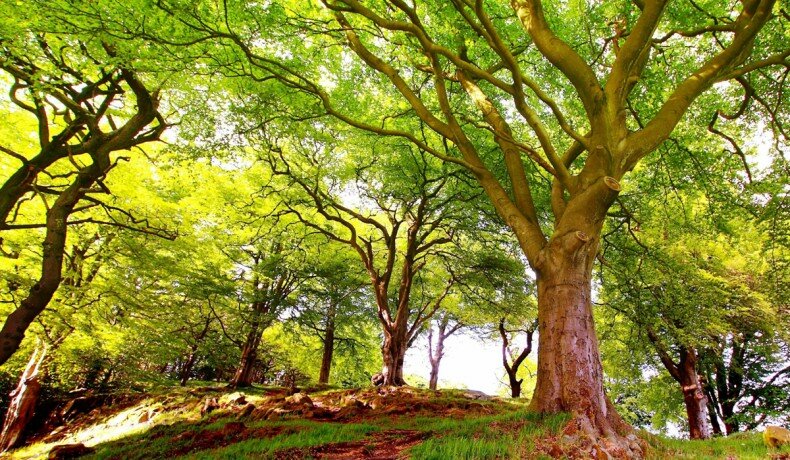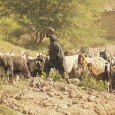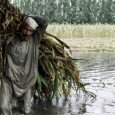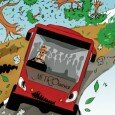By Amar Guriro –
No one including ‘vibrant’ media paying attention to tree terrorism in Karachi
Though Karachi is notorious for its — what they call it ‘targeted killings’ a typical phrase used in which gunmen select a man as their target, come on motorbike, shoot the target and roll away silently. But apart from such incidents, Karachi has other almost same type of phenomena that is not done by the armed gunmen, but by the government officials and it is also not reported by so-called national media of Pakistan. It is cutting of centuries old indigenous trees in the city, pushing this fast growing mega city, which is already declared one of the polluted cities, towards a natural disaster.
One of such of brutal incidents happened on late January when in the darkness of the night officials of Karachi Municipal Corporation (KMC) laden with modern crosscut saws reached on Sir Ghulam Hussain Hidayatullah Road, just few yards away from historical Karachi Press Club (KPC), the road which was named after the “grand old man of Sindh” who became first chief minister of Sindh when it was separated from Bombay. Within no time, KMC staff cut down a huge size Banyan tree, which is said to be 250 years old, just in front of the MPAs hostel.
 Just a month before the spring weather in city, which is said to be tree plantation season, the officials, instead of planting new trees are cutting the city’s historical trees. But this is not first of its kind incident, in which public departments have cut down a tree in the city, but according to a report, in 1947, the Pakistan’s biggest city of Karachi had 18 percent of its total geographical area covered with urban forests, which comprises on indigenous tree, has now lost much of its trees. In 2008, former City District Government Karachi (CDGK) estimated that Karachi has remained only 7 percent of its forest cover.
Just a month before the spring weather in city, which is said to be tree plantation season, the officials, instead of planting new trees are cutting the city’s historical trees. But this is not first of its kind incident, in which public departments have cut down a tree in the city, but according to a report, in 1947, the Pakistan’s biggest city of Karachi had 18 percent of its total geographical area covered with urban forests, which comprises on indigenous tree, has now lost much of its trees. In 2008, former City District Government Karachi (CDGK) estimated that Karachi has remained only 7 percent of its forest cover.
Being Pakistan’s largest city and an industrial and commercial hub, Karachi needs more trees for balancing the ecosystem, but different civic bodies have continued to cut down trees, usually with a lame excuse such as the trees were hindering utility services, damaging footpaths or being an obstacle for electricity wires and sewerage lines or on the name of widening the roads and constructing bridges. Sometimes, authorities even remove the old trees in city if they want to erect huge size roadside advertisement billboards.
Not this alone, but also the mangrove forests along the 129-kilometer long Karachi coast, one of the most important coasts of Indus delta, are on the verge of destruction due to an increasing level of marine pollution, pouring of domestic and industrial waste into the sea, and massive cutting of mangroves to grab the land for residential and commercial purposes. Mangroves are supposed internationally as coastal Sepoy that protect coastal cities from tropical cyclones, tsunamis, produce oxygen for city and provide breeding ground for many types of fish species and also are the nesting areas of several types of birds.
Besides cutting mangrove forests, which are also known as Lungs of city, Karachi authorities are throwing solid waste, raw sewage, as there is no proper system to filter sewerage in the city and even they allow more than 15000 industrial units in five industrial zones in the city to throw their waste, which even comprises highly contaminated waste from tanneries to throw into Arabian Sea without treatment.
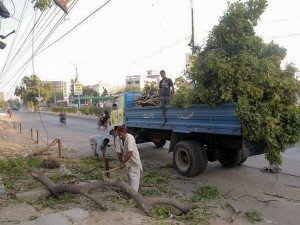 Beside that mangroves also chopped down on mass scale to be used as fuel wood and used by Tandoor venders in the city and also some of the industrial units are using mangrove wood as industrial fuel due to the frequent natural gas shutdowns in the city.
Beside that mangroves also chopped down on mass scale to be used as fuel wood and used by Tandoor venders in the city and also some of the industrial units are using mangrove wood as industrial fuel due to the frequent natural gas shutdowns in the city.
Gauging the situation of worsening deforestation, in 2008, former City District Government Karachi (CDGK) Nazim Mustafa Kamal led government, planned Karachi Comprehensive Plan (KCP), a detailed plan for greener Karachi, under the title “Forestation, Aesthetic Plantation and Landscaping Study-Karachi Comprehensive Plan”, with cost of an estimated Rs8.34 billion, to plant a variety of trees for better environment. The basic aim behind spending such huge cost was to increase the forest cover of the city from its 7 percent of the total geographical area to the 14 in next ten years.
Under the plan, it was planned to plant a variety of trees in Karachi, which include Banyan, (Neem) Tree, Margosa, Coconut, Plaksa tree (Peepal) and as Karachi is tropical as well as arid, therefore under the plan other tree species such as Siris, Rain tree, Ashoka, Amaltas, Cassia species like Terminalia (Indian Badam), Peltophorum (Copper pod), Gulmohar, Palm trees, Molseri and also Lignum vitae were planned to be planted in the city to increase the forest cover. The outputs of the plan were kept for substantial and sustainable environmental benefits besides beautification of city.
Beside, forestation, aesthetic-plantation and landscaping, the actual purpose of the plan was also included the beautification of the city, increase tree cover, apply modern landscaping techniques, encourage farm and social forestry in and around city to check green house effect, minimise threats to ecological integrity through carbon sequestration and improve bio-geochemical processes.
But such a great planning and huge amount of money went wasted, as instead of acquiring all these purposes, former CDGK introduced only one species, the Conocarpus and thus despite restoring the city’s urban forests, it has introduced, what the experts term “Monoculture”, which brought another problem. According to the environmentalists, monoculture means planting of single tree species in certain area, which has disturbed the biodiversity. And also the monoculture creates a similar environment, hindering bird population, forcing them to migrate, since different birds have varying nesting habits and prefer different trees. A recent study reveals that number of bird pollution has reduced drastically in Karachi and only number of kites have increased, which is basically a scavenge bird and its increasing population confirms that how much the city has became dirty.
The selection of Conocarpus again brought a new problem as experts say that Conocarpus will bring adverse impacts on city’s general environment. Muhammad Moazzam Khan, the fisheries consultant for World Wide Fund for Nature (WWF)-Pakistan, quoting international studies said that Conocarpus is notorious plant species for causing droughts in several regions. “In future Conocarpus will start releasing pollen, which will cause pollen allergy just like Islamabad,” he told Pique.
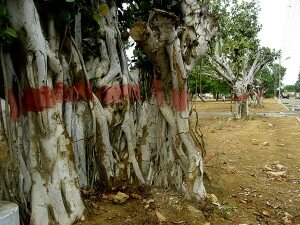 Stressing the importance of the indigenous tree, nature conservationists insist on planting local trees. “Before mass scale plantation, the carbon value of the selected tree species must be check, which means how much carbon they will sink and also how much oxygen they will provide, there this will not serve the purpose, as we need indigenous tree species with broader leaves, because as much as the leaf of any tree will be broad, it has capacity to sink more carbon and also release more oxygen,” International Union for Conservation of Nature (IUCN) official Nadeem Mirbahar told Pique.
Stressing the importance of the indigenous tree, nature conservationists insist on planting local trees. “Before mass scale plantation, the carbon value of the selected tree species must be check, which means how much carbon they will sink and also how much oxygen they will provide, there this will not serve the purpose, as we need indigenous tree species with broader leaves, because as much as the leaf of any tree will be broad, it has capacity to sink more carbon and also release more oxygen,” International Union for Conservation of Nature (IUCN) official Nadeem Mirbahar told Pique.
However, coastal expert argue that Karachi has long coastline where by planting mangroves, city’s forestation can be restored. “Mangrove produce fresh air and also protects city from disasters like cyclone and will increase fish population and also we can earn carbon points in the international carbon market,” said Sindh Forest Department’s Sea Intrusion Project official Agha Tahir Hussain.
With large number of industries, growing number of private vehicles due to the lack of the public transport, with increasing population that increased energy needs, Karachi is one of the most polluted cities in the world in terms of air pollution. A study conducted by World Health Organization (WHO) under the title “Ambient (outdoor) air pollution in cities database” in 2014 for which air pollution was monitored in 1600 cities in 91 countries and Karachi is on Number 05.
With an arid climate, rapid growing population, reducing freshwater sources and massive tree cutting and replacing it with controversial plant species, Karachi is fast moving towards natural disasters. But clear warning by the nature conservationists, authorities have not any planning for the Karachi and business tycoons are introducing mega project in Karachi, especially along the Arabian Sea, which according to the experts will bring disaster in the near future. As a part of arrangements to protect city from disasters and keep its environment clean, environmentalists urge not only restoration of city’s forest cover but also massive level plantation along the Karachi coast.
“When population grows, so the pollution grows and also the energy requirements increase, which causes more emissions in the city atmosphere, therefore, it is very important to start massive tree plantation on emergency basis,” said renowned forest expert Gobind Menghwar.
The writer is a Karachi-based journalist and IVLP Alumni. He tweets @AmarGuriro





















































































